In January, for this site, Diego Estan reviewed Q Acoustics’ Concept 300 loudspeaker ($4499/pair including stands; all prices USD). Last year, Roger Kanno reviewed Q’s diminutive 3020i minimonitor ($314.99/pair) for this site, and Hans Wetzel reviewed Q’s big 3050i floorstander ($839.99/pair) for SoundStage! Access. Preceding Roger’s and Hans’s reviews was my column about the 3020i and 3050i. So two months ago, when Q Acoustics asked if they could send me samples of their newest 3000 model, the 3030i minimonitor ($399/pair), I declined -- I felt that we and our readers were maybe a bit Q’d out.
Two weeks later, I had second thoughts. I realized that while Diego, Roger, Hans, and I had all liked the Qs we wrote about, none of us was so knocked out by any of them to recommend it over any other company’s similarly priced models. Maybe it was better to give Q another chance after all.
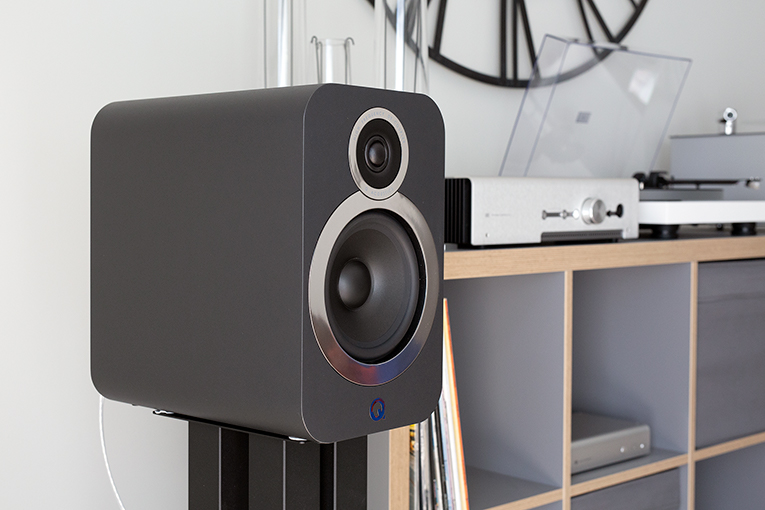
They sent me a pair of 3030i’s.
Description
Q Acoustics’ 3030i looks like a slightly bigger version of their 3020i. Both are two-driver two-ways that share the same 0.9” soft-dome tweeter, and have one paper-cone midrange-woofer in an MDF enclosure. But while the 3020i’s 5” midrange-woofer is mounted in a cabinet 11”H x 6.7”W x 11.1”D, the 3030i has a 6.5” midrange-woofer and its cabinet measures 12.8”H x 7.9”W x 13.0”D. (That 6.5” driver looks the same as the one used in the 3050i, which has two of them, one above and one below that same 0.9” tweeter.) Its larger driver and cabinet allow the 3030i to go deeper in the bass than the 3020i -- Q specifies the 3030i’s -6dB point as 46Hz, the 3020i’s as 64Hz. That difference of 18Hz is, as you’ll read below, significant. But despite that difference in these models’ specified low-end responses, Q specs nominal and minimum impedances as a respective 6 and 4 ohms, and their sensitivity as 88dB/2.83V/m.
The 3030i’s arrived in the finish I’d requested, Graphite, which I figured would photograph well and best complement the rest of the components in my current System One, which is set up along a short wall of my 18’L x 15’W living room. I also chose that finish because I’d already seen the 3020i in White, which I thought looked modern and appealing, and the 3050i in English Walnut vinyl veneer, which I didn’t like -- it looks dated. The fourth available finish, Black, sounded too dark -- but if another 3000-series Q comes out, I might be inclined to give it a ride just to experience it.
The Graphite, White, and Black are not paint but monochrome laminated finishes that might be melamine, which I like for its durability. Melamine, commonly used in kitchen countertops, is almost indestructible; paint and real-wood finishes are much more easy to damage.
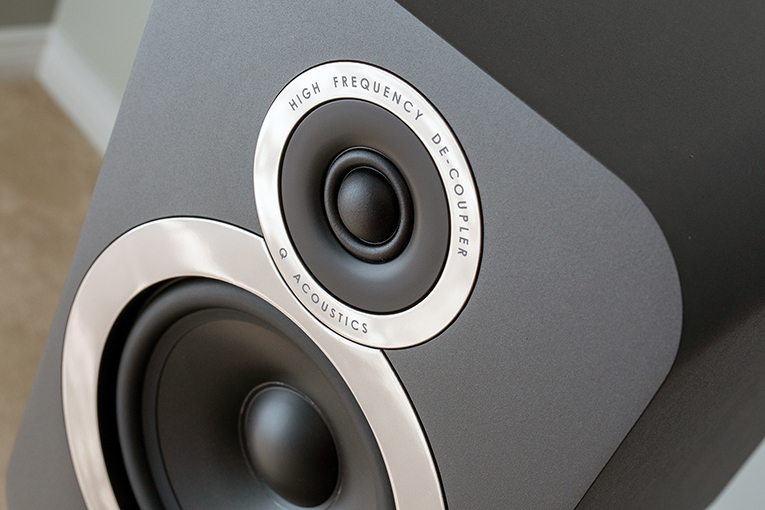
Like the cabinets of all of Q’s 3000 models, the 3030i’s is strategically braced inside to reduce resonances. (In their promotional materials, Q talks about using computer optimization to do this.) The tweeter is decoupled from the midrange-woofer, so that vibrations from the larger driver can’t affect it. Another feature of the 3000 cabinets are their corner edges, which are generously rounded from front to back. I doubt the rounding does much to help the sound -- you’d have to round the edges around the front baffle to improve the sound by reducing diffraction -- but it’s a welcome addition that makes the speaker look more attractive.
Prettying up the speaker further are shiny rings that surround the drivers and conceal their bolts. And if you don’t want to see the rings and drivers at all, thin, magnetically attached grilles are supplied, which also add protection. (I used the 3030i’s with and without the grilles, but for my most serious listening, they were off.) Around back, below the bass port, are low-profile binding posts that work well and look good. The speaker’s internal wiring is by QED, a sister brand to Q Acoustics.
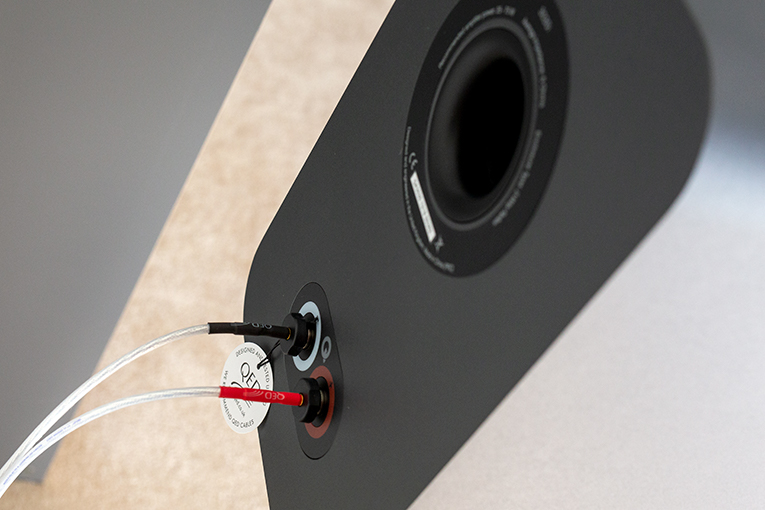
Conveniently, Q attaches little rubber footers to the bottom of their 3000 stand-mounted models, to make them more stable on flat surfaces, and to keep them from scratching those surfaces. If you want to plunk one down on a shelf, as I did with the 3020i’s and my IKEA shelving unit, go ahead. But I used the 3030i’s atop the 24”-high Monoprice Monolith stands ($109.98/pair) I wrote about in February 2020.
Powering the Q 3030i’s speakers for my listening tests was Schiit Audio’s Ragnarok 2 Fully Loaded integrated amplifier ($1799), which is specced to output up to 60Wpc into 8 ohms, and which I wrote about in April 2020. Connecting the Schiit to the speakers were QED XT25 speaker cables ($84.99/2m pair; I wrote about these in October 2019). This meant that my review samples were wired by QED inside and outside. I connected my Pro-Ject X1 turntable ($899) to the Ragnarok 2’s built-in moving-magnet phono stage, but for digital streams from Tidal I used a Google Chromecast Audio streamer ($35, discontinued) connected via TosLink to a Schiit Bifrost 2 DAC ($699), which I also wrote about last month. The two Schiits were connected with a 1m length of J&D balanced interconnect (ca. $20).
Q sound
In my previous Q Acoustics write-up, I said that I preferred the much-less-expensive 3020i, mostly because it sounds clearer through the midrange than does the 3050i. But the 3020i still wasn’t ideal -- its sound is light in the bass, to the point that many listeners would be happy with it only if they used it with a subwoofer. So it’s no surprise that I feared the same would be true of the 3030i, even with its bigger midrange-woofer and cabinet.
But moments after I dropped the needle on side 2 of Bruce Springsteen’s Tunnel of Love (LP, Columbia COC 40999), and heard the kick drum at the beginning of the title track, I knew that bass weight would not be a problem. The 3030i’s sounded solid and fully fleshed-out to below 50Hz -- pretty low for a minimonitor. In fact, they provided some of the weightiest bass from a speaker of this size that I’ve heard in this system, regardless of price.
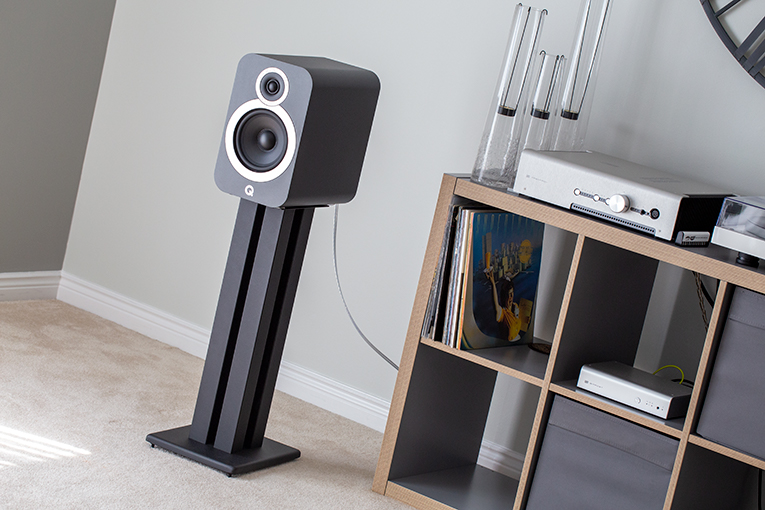
But what about the midrange -- did the 3030i’s weightier bass muck it up? When Springsteen’s voice enters, singing “Fat man sitting on a little stool / Takes the money from my hand while his eyes take a walk all over you,” its clarity seemed on a par with the excellent clarity I remembered from the 3020i. And by the time I got to my favorite track on this album, “One Step Up,” and heard Springsteen’s lead and Patti Scialfi’s backing vocals both so clearly reproduced, and so distinct from each other on the soundstage, I was growing confident that the 3030i represented a giant step up from the 3020i -- and for only $84.01/pair more. What’s more, even though the 3030i’s’ bass in my room didn’t reach quite as low as I remembered experiencing with the 3050i’s, it went deep enough to be completely musically satisfying. And the 3030i sounded much clearer through the midrange than the 3050i -- for $440.99/pair less.
That confidence I felt in the 3030i’s sound grew the very next day. My wife turned on System One, as she usually does on Saturday’s when she’s cleaning the house, and this Saturday she settled on the soundtrack to the classic disco film Saturday Night Fever (16-bit/44.1kHz FLAC, RSO/Tidal). If a pair of speakers doesn’t have enough bass and/or doesn’t sound clean, she always calls out, “These don’t sound good!,” in hopes I’ll come over and swap them out for something else -- I always have several pairs of speakers around. She’s no audiophile, but she appreciates good sound, and won’t listen if it isn’t up to scratch. That never happened with the 3030i’s. Instead, she called me over to complain that she couldn’t get them to play loud enough. When I explained the Schiit Ragnarok 2’s multiple gain settings, and that she needed to switch it to the highest gain to get the party-level volume she wanted from these speakers, she did so and was content. To me, her acceptance of the 3030i’s said a lot about how satisfying they’ll sound for most listeners.
After my wife had finished cleaning to the sound of the 3030i’s, I took over the room to continue with Saturday Night Fever. I’d been so taken with the sound of the Bee Gees’ “How Deep Is Your Love” from another room that now I wanted to listen critically to the track. Sitting in the sweet spot in the middle of the couch, I was bowled over by the fullness of the bass and the clarity of the midrange, and by how good a job the inexpensive little Qs did of getting out into the room a sound that was big, clear, and fulsome, driven only by an integrated amplifier of moderate power output.
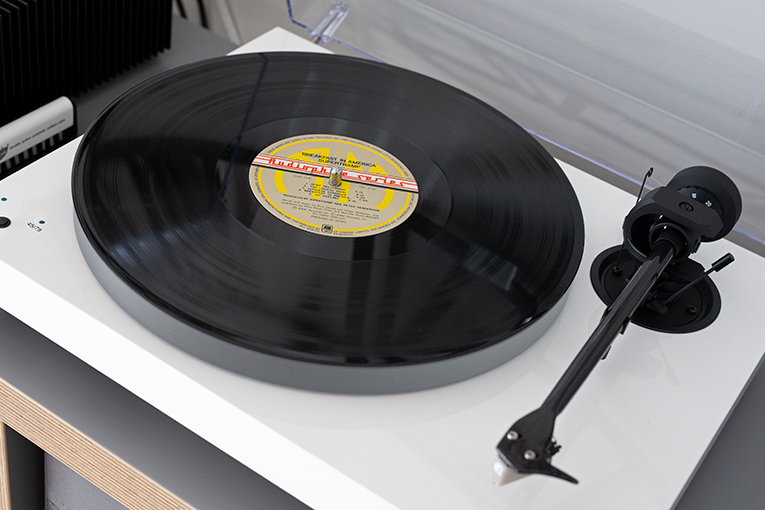
I continued the 1970s vibe with Supertramp’s Breakfast in America (LP, A&M Audiophile Series SPJ-3708), which I’d bought in my teens. Different tracks highlighted different characteristics of the 3030i. For example, the first tracks on sides 1 and 2, “Gone Hollywood” and “Take the Long Way Home,” each have a lot going on with cymbals, and showed me that the 3030i’s tweeter had excellent upper-frequency extension and plenty of energy, while never sounding bright. Yet it was “Just Another Nervous Wreck” that really bowled me over, for several reasons. Again, the cymbals crashed without sounding splashy or harsh, and composer Rick Davies’s voice imaged prominently at center stage with a healthy dose of presence but never sounded chesty -- the soundstage spread beyond the speakers’ outer side panels, and the drums really walloped, fleshing out the low end in a way I’d never thought a pair of $399/pair stand-mounted speakers could.
The next track, “Casual Conservations,” revealed even more about the 3030i’s midrange -- Davies’s voice was reproduced with great clarity and warmth, but never sounded too warm or in any way obscured -- my chief complaints about Q’s 3050i. And the album’s next and final track, “Child of Vision,” reinforced what I’d heard with “Just Another Nervous Wreck”: the kick drum was reproduced with great weight and tautness, while the prominent keyboards toward the end exhibited the clarity of the 3030i’s midrange.
Then, on Sunday, I jumped 40 years forward to “Happiness Is a Butterfly” and “Hope Is a Dangerous Thing for a Woman Like Me to Have -- But I Have It,” both from my favorite album of 2019: Lana Del Rey’s Norman Fucking Rockwell! (16/44.1 FLAC, Interscope/Tidal). I’ve found that Del Rey’s voice and piano in these tracks can excite cabinet resonances in some speakers that make them sound glassy and/or resonant and unclear. But the high-flying 3030i’s skated through both tracks, keeping their midband in complete control, and with the kind of clarity I expect from speakers costing $1000/pair or even a little more.
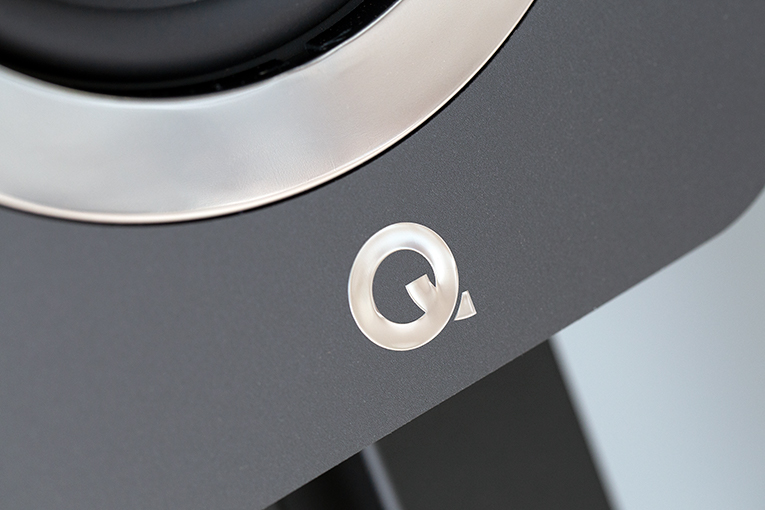
I then jumped to acoustic jazz and “Devil May Care,” from singer-pianist Kandace Springs’s brand-new album, The Women Who Raised Me, featuring Christian McBride (16/44.1 FLAC, Blue Note/Tidal). Through the 3030i’s, McBride’s double bass laid a taut, tuneful foundation, while Springs’s voice and piano jumped out prominently, again thanks to the 3030i’s outstanding midrange clarity. But the lowest notes from McBride’s bass lacked some energy around 40Hz. But that was mere nit-picking, considering how much bass the 3030i’s did reproduce -- their sound was robust and satisfying in a way that should please most listeners.
On the next track, “Angel Eyes,” Springs duets with Norah Jones, whose distinctive voice can sometimes sound a bit wispy as well as too sibilant, depending on the recording. Not here -- through the 3030i’s, the wispiness was present, but it never sounded over-accentuated or off-putting, and I never heard an excess of sibilance.
To be sure, I played the title track of Jones’s own Come Away with Me, along with “Don’t Know Why” and “Feelin’ the Same Way” (16/44.1 FLAC, Blue Note/Tidal). I knew that if I was going to hear too much wispiness and/or sibilance, it would be with these tracks, because I’ve heard them many times before through speakers that over-emphasize the upper frequencies. The 3030i’s reproduced “Don’t Know Why” and “Feelin’ the Same Way” without incident; only “Come Away with Me” teetered on the edge of too much wispiness and sibilance, but ultimately it didn’t quite go over that edge. It’s tough to voice a loudspeaker to produce an ideal balance -- whoever voiced the 3030i nailed it, from the highs through the lows.
Killer Q
The sound of Q Acoustics’ 3020i impressed me for the price -- as did its appearance and compact size -- but its lightweight bass precludes an unqualified recommendation. On the other hand, while Q’s 3050i produces ample bass, its midrange isn’t as clear as the 3020i’s, or as clear as I would have liked from a speaker costing $839.99/pair, so my recommendation of it, too, can’t go unqualified.
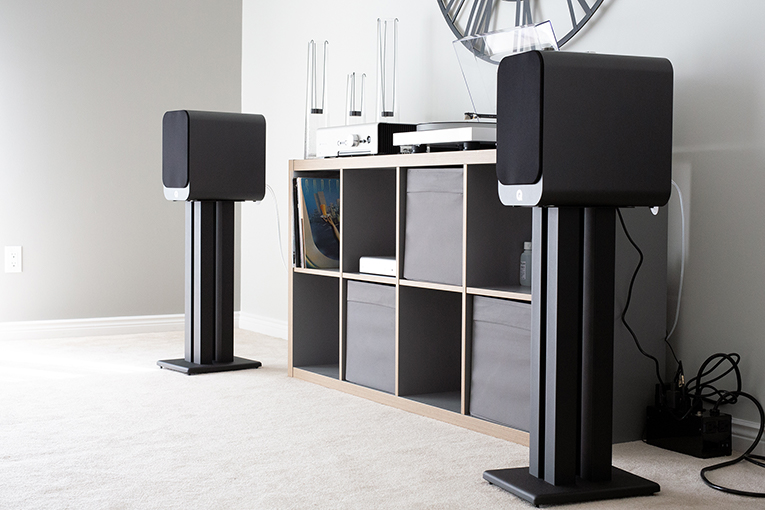
Enter the Q 3030i. Though it costs only a little more than the 3020i and less than half the price of the 3050i, to my ears its overall voicing and clarity make it better than either -- and one of the best budget speakers now on the market. I’ve finally found a Q Acoustics speaker that I can, without caveat or hesitation, enthusiastically recommend to audiophiles on a budget -- or to anyone who wonders just how good a $399 pair of speakers can sound.
. . . Doug Schneider
das@soundstagenetwork.com
Manufacturer contact information:
Q Acoustics
Armour Home Electronics
Woodside 2, Dunmow Road
Bishop’s Stortford, Hertfordshire CM23 5RG
England, UK
Website: www.qacoustics.com






















